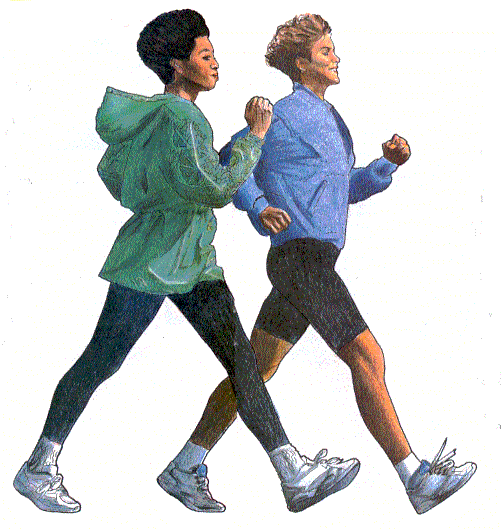
Plan Your Ideal Walking Workout By Sarah Bowen Shea
Make every step count, no matter how often you hit the pavement.
If You Walk Occasionally...
Routine: Begin by walking 10 to 15 minutes on flat ground or on a treadmill at a purposeful pace, or complete 2,000 steps (use a pedometer to monitor your walking progress). "You want to cover a mile in about 20 minutes. That's not a window-shopping pace," says Mark Fenton, a former competitive racewalker and the host of the PBS series America's Walking.
Walking tips:
Maintain an upright but comfortable posture, with your neck, upper back, and shoulders relaxed, suggests fitness-walking expert Sara Donovan, author of Mall Walking Madness: Everything You Need to Know to Lose Weight and Have Fun at the Same Time.
Minimize the sway in your lower back; don't jut your rear out. Instead, maintain a slight, natural arch in your back.
Gently pull in your abdominal muscles. This helps strengthen your abs while reducing lower-back pain.
Goal: Aim to walk at least five days a week. Every second or third week, add 5 minutes. After about two or three months of regular walking, you should be up to 30 minutes. Once you've hit half an hour, add variety to your terrain rather than increasing time or speed. This will boost your enjoyment, encouraging you to keep up the habit.
If You’re an Everyday Walker...
Routine: If you're already walking for at least 30 minutes a day, you may be ready to make your routine less routine. Concentrate on increasing distance and speed, gradually working up to 45 minutes. Pick up the pace until you're walking a mile in 15 to 18 minutes. (Wear a pedometer, or use your car to measure your route.) To speed up, take faster steps, not longer strides. "There's a physical limit to stride length, but as your fitness improves you can always take quicker steps," says Fenton, who is also the author of The Complete Guide to Walking for Health, Weight Loss, and Fitness.
Walking tip: Bend your arms to about 90 degrees. That turns them into shorter, more compact pendulums. You'll be able to swing them faster and thus help your legs and feet move faster. (Just try running with straight arms.)
Goal: Set your sights on taking 10,000 steps every day, which adds up to about five miles. You'll take half of those steps just by going about your daily life―grocery shopping, climbing stairs. The rest, about 2½ miles, you'll need to add by fitness walking.
If You’re an Athletic Walker...
Routine: Speed-walking means setting about a 12-minute-mile pace. Racewalking, an Olympic sport, is even more challenging. Both take concentration. Unless you continually remind your feet to move unnaturally fast, you'll slow down.
Walking tips:
To visualize racewalking, think of children running around a pool and being told by the lifeguard to walk, not run, says Fenton: "Imagine their upright posture, quick steps, fairly straight legs, and bent arms."
Take fast steps: World-class female racewalkers maintain a blistering 200-steps-per-minute pace (or a 7- to 7.5-minute mile) for 12 miles.
Goal: You could walk two miles in 25 minutes at this pace. Or you could keep your workout interesting by following these two strategies:
Intersperse 10 one-minute bursts of speed-walking or racewalking throughout a moderately fast 45-minute walk.
Become a hiker. "Going up hills is the best intensifier," says author Mark Fenton. Even though you may not walk as fast as you could on flat ground, you'll boost your workout substantially. According to experts, you expend significantly more energy hiking up a 10 percent incline than walking at the same pace on level ground. And because you're moving up and down in addition to forward, your calf and thigh muscles will develop more tone.
source

No comments:
Post a Comment